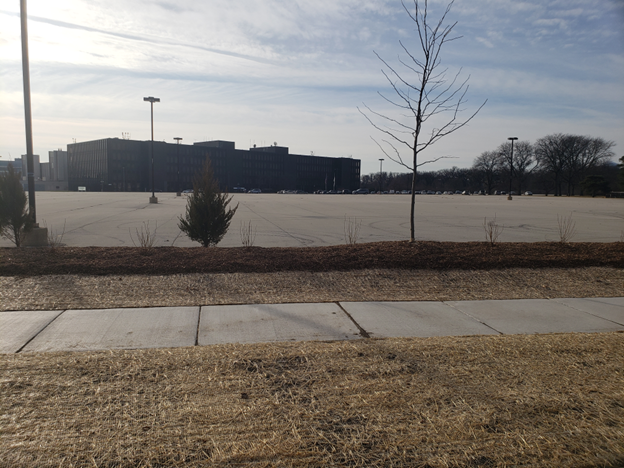There they sit, large office parks adjacent to an interstate highway, monuments to post World War II growth and prosperity in Naperville, a suburb west of Chicago. But now they sit almost empty, often with just a couple dozen cars in a parking lot designed for thousands of cars.
This is the view from the newly constructed townhome that Naperville residents Joe McElroy and his wife Kay recently purchased.
Globalization, modern communication technology and the Covid pandemic are combining to pose new challenges for city planners and other public officials, Joe McElroy said, not just in Naperville but in cities nationwide.
“I’m told this land was part of a parking lot, which was even bigger when Bell Labs was here,” said Joe McElroy, an urban planner with a long background in city planning and adaptive reuse.
“At its peak, more than 10,000 people worked locally at AT&T Bell Labs, which was Naperville’s largest employer,” McElroy said. “The parking lot would be crowded, and the huge amount of traffic led public officials to expand the nearby roads to accommodate all the traffic.”
Those five-lane intersections are seldom busy now, he noted.
Down the road sits the former Amoco Research Center, where thousands more once worked. Today a chemical company has taken some of the space, but the campus is a shadow of its former self.
Drawn by the East-West Tollway, which opened in 1959, Bell Labs and Amoco came to Naperville in the 1960s and were major employers for decades. Both provided well-paying, high-tech jobs that attracted thousands of people. Naperville’s population soared from 13,000 in 1960 to 128,000 by 2000.
But eventually globalization and technology—especially the Internet–changed the corporate landscape. In 1998 Amoco merged with British Petroleum, with corporate headquarters moving from Chicago to London. Lucent split off from the Bell system and later was sold to Alcatel, a French company, and then to Nokia, based in Finland. Thousands of layoffs ensued.
Today Nokia is still a major employer locally, but much of the staff works remotely in the wake of Covid pandemic.
“One of our new neighbors said he works for Nokia but seldom walks across the parking lot to his office,” McElroy said. “He’s only a very short walk away, but he prefers to work at home.”
Due to changing attitudes like these, those large, five-lane roads near the tollway interchange—once jammed during rush hour—are no longer as needed, but they still must be maintained, with taxpayers on the hook for snow plowing and periodic repairs.
Faced with these types of issues, some places will adjust and continue to prosper, while others will decline.
What will make the difference? Joe McElroy points to innovative responses to changing conditions, such as the redevelopment of regional malls. Once Meccas for shopping and socializing—think teens in movies like 1982’s “Fast Times at Ridgemont High,” many malls today are dead or shadows of their former selves.
In Aurora, a large suburb adjacent to Naperville, the Fox Valley Mall, with 1.5 million square feet of retail, dominated the shopping scene since opening in 1975. But now Sears Roebuck and another anchor store have been demolished and are being replaced by open space and hundreds of apartments, some aimed at senior citizens.
“The redevelopment of a major property like this takes a lot of cooperation between the private and public sectors,” said McElroy, who was Aurora’s deputy director of city planning in the 1980s, when Fox Valley Mall was an economic, tax-generating powerhouse.
“There are always tax implications,” he said. “Developers will seek financial incentives, but city officials have to make sure there is enough funding available for police, fire, roads, social services and other public needs.”
Faced with rapid changes, cities need to think strategically, according to Joe McElroy, a process that can include the following steps:
- SWOT Analysis: Examine local Strengths, Weaknesses, Opportunities and Threats. In Naperville, where McElroy was vice chairman of the city’s Plan Commission, the community’s strengths include excellent schools, low crime and a sales tax base that remains strong despite the rise of online shopping. Weaknesses include traffic congestion and weak support for historic preservation.
- Mission Statement: Based on the SWOT analysis, the mission statement identifies the community’s broad goals for economic development. Should the priority be employment opportunities, public safety, transportation improvements or something else?
- Issues Analysis: Identify future opportunities and threats such as regulatory changes. If state or federal government mandate new environmental regulations, how will the community pay for them? Also, what economic changes could be in store? Will inflation discourage shoppers? Will mortgage interest rate changes slow or accelerate the housing market? What about demographic changes? Is the local population aging, or are there many young families moving in?
- Goals and strategies: Based on the mission statement and issues analysis, develop goals and specific statements of what the community wants. This then leads to strategies, specific actions that identify how the goals will be reached.
- Action Items: This is where the rubber meets the road. To meet its goals and implement strategies, the community must determine cost, personnel requirements, time frame, legal implications, etc.
- Impact Assessment: This step usually comes months or years later. Were the strategies and action items implemented? If so, did they succeed? If not, why not? Assessment informs next steps.
Clearly city planning should be an ongoing process. “We know that strategic plans are not always implemented” Joe McElroy said. “But that doesn’t mean we shouldn’t keep trying. Planning is imperative for success in a rapidly-changing world. Without it, we are just creating expensive chaos.”









